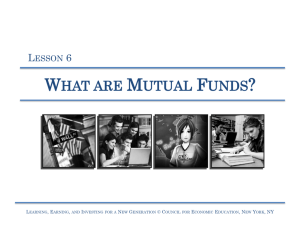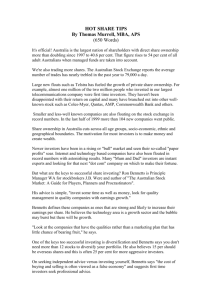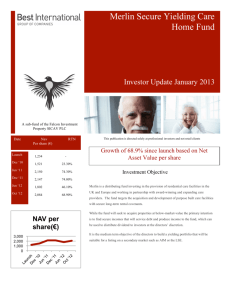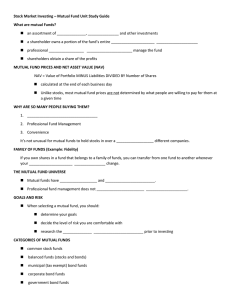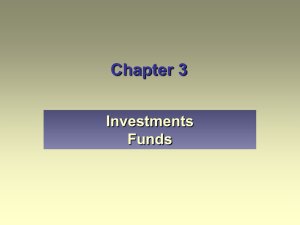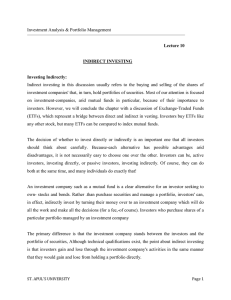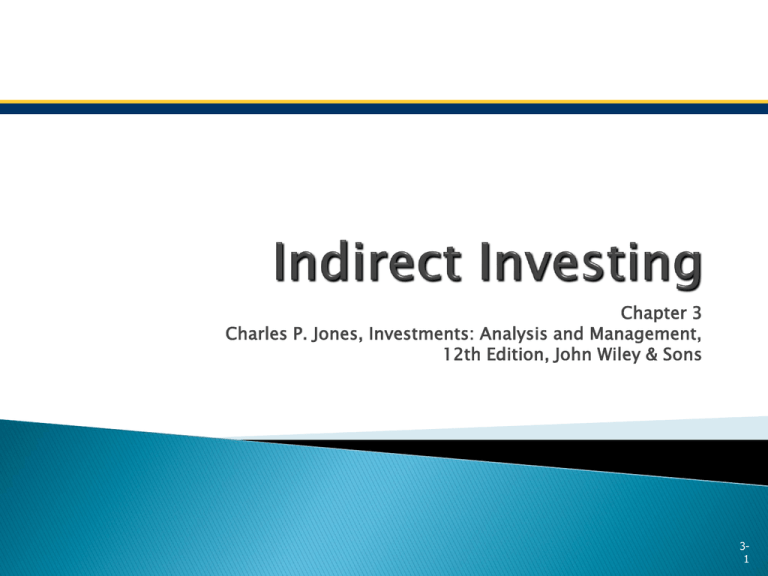
Chapter 3
Charles P. Jones, Investments: Analysis and Management,
12th Edition, John Wiley & Sons
31
Alternative to direct investment in or
ownership of securities
◦ Accomplishes essentially the same thing as direct
investing
Refers to buying and selling the shares of
intermediaries that hold securities in portfolio
◦ Shares are ownership interest in portfolio entitled
to portfolio income
◦ Shareholders also pay expenses and management
fee
32
Firm that sells shares to the public and uses
the proceeds to invest in marketable
securities
◦ Acts as conduit for distribution of dividends,
interest, and realized gains
◦ Offers professional management
◦ Regulated but not insured or guaranteed by any
federal agency
◦ Shareholders pay taxes as if they directly owned
securities
33
Unit Investment Trust (UIT)
◦ Typically holds an unmanaged, fixed-income
portfolio
◦ Relatively small share of market
Closed-End Investment Company
◦ Actively managed portfolio
◦ Fixed number of shares
◦ Trade on stock exchanges like other stocks
34
Exchange Traded Funds
◦ Portfolio of assets that tracks a sector, region, or
market
◦ Trade like individual equities on exchange
◦ Management fees low
Typically unmanaged portfolios
◦ Tax efficiency
Investor has greater control over realization of capital
gains/losses than with a mutual fund
35
Mutual Funds (Open-end Investment
Companies)
◦ Investors buy fund shares from investment
companies, sell shares back to those companies
Mutual funds not sold on exchanges
◦ Number of shares outstanding constantly changing
(unlike closed-end funds)
◦ Offer diversification, professional management,
other services
◦ Popular with investors, especially in retirement
plans
36
Money Market Funds (MMFs)
◦ Invest in portfolio of money market securities
◦ Taxable or tax-exempt
◦ Investors pay a management fee but not a sales or
redemption charge (load)
◦ Not insured by the federal government
◦ Attempt to keep price at $1/share
◦ Offer investors broad diversification, great liquidity
and a way to earn going money market rate
37
Equity, bond, and hybrid mutual funds
◦ Equity funds hold primarily stocks, bond funds
primarily hold bonds and hybrid funds hold a
combination
◦ All invest in portfolio of securities consistent with
the objectives of the fund
◦ Company’s board sets objects, must specify them
in investment policy
◦ Objectives can be achieved in various ways, so
investment style can also be important
38
Most equity funds are either:
◦ Value funds, which invest in stocks that are cheap
according to standard financial analysis methods
◦ Growth funds, which invest in stocks of firms
expected to show future rapid earnings growth
These fund types tend to perform well at
different times, appeal to investors with
different objectives
Best strategy is probably to hold both fund
types
39
Index Funds
Mutual Funds designed to match a market
index
Unmanaged portfolio, typically with low
expense ratio
◦ Expenses vary widely, though, so investors need to
be sure expenses are reasonable
Often outperform actively managed mutual
funds
310
Net Asset Value Per Share (NAV)
NAV is per share value of securities in a fund
Is the total market value of securities, minus
any liabilities, divided by number of shares
outstanding
Changes daily and is calculated daily after
markets close at 4 p.m.
If no sales charges, NAV is price investors pay
to buy mutual fund or price paid to investors
selling fund
311
The Details of Indirect Investing
Closed-end funds
◦ Market prices often differ from NAV
◦ Market price may be less than NAV (discount) or
more than NAV (premium)
◦ Portfolio’s return calculated based on NAVs
◦ Shareholder’s return calculated based on closing
prices
Individual investors should avoid purchasing
newly offered shares of closed-end funds
312
The Details of Indirect Investing
Mutual Funds
Investors can purchase directly or indirectly
Usually only require a small minimum investment
Investors can redeem shares anytime
Investors purchase/redeem at NAV plus or minus
sales charges
◦ Fund’s prospectus discloses fees and expenses
◦
◦
◦
◦
Load funds charge a sales fee
No-load funds do not charge a sales fee
313
The Details of Indirect Investing
Mutual Fund Share Classes
◦ Way to give investors choice over fees
◦ Each class has same claim on portfolio, same NAV
No-load funds
◦ Purchased at NAV directly from the investment
company
◦ No sales force expense to cover
◦ Investors must seek out funds
◦ Annual operating expenses paid out of fund income
All funds charge shareholders an expense
ratio
314
The Details of Indirect Investing
Exchange-Traded Funds
◦ Can be bought or sold anytime during the trading
day
◦ Can be bought on margin or sold short
◦ Have much lower expenses than actively managed
funds
◦ Can weight indexes differently, which can affect
return
315
Reported on a regular basis in the popular
press
Price performance not the same as total
return
◦ Total return measures both price changes and
income (from dividends) over a specified time
period
◦ Average annual return is a hypothetical measure
Costs and taxes should also be considered
Expenses may be the best indicator of a
fund’s performance
316
Some mutual funds specialize in international
securities
◦ Can have higher costs
◦ International funds or global funds emphasize
international stocks
◦ Single-country funds concentrate on one country
◦ Some ETFs match foreign indexes
Not hedged against currency risk
317
The Future of Indirect Investing
Mutual fund “supermarkets”
◦ Investors can buy/sell funds from various mutual
fund families through a single source
◦ Offer fee and no-fee “aisles”
Hedge Funds
◦ Largely unregulated investment companies
available to private investors
May use leverage, derivatives, other strategies not
available to mutual fund managers
Require substantial initial investment, charge
substantial fees
318
Copyright 2013 John Wiley & Sons, Inc.
All rights reserved. Reproduction or translation of
this work beyond that permitted in section 117 of
the 1976 United States Copyright Act without
express permission of the copyright owner is
unlawful. Request for further information should be
addressed to the Permissions Department, John
Wiley & Sons, Inc. The purchaser may make backup copies for his/her own use only and not for
distribution or resale. The Publisher assumes no
responsibility for errors, omissions, or damages
caused by the use of these programs or from the
use of the information herein.
319


